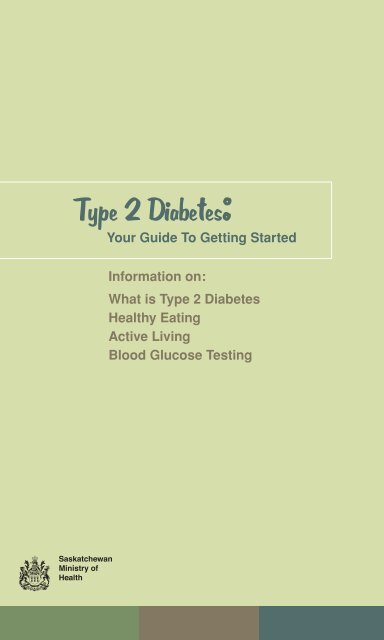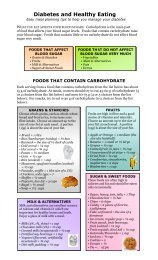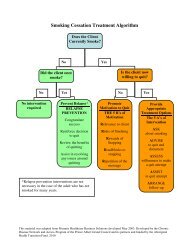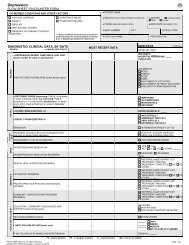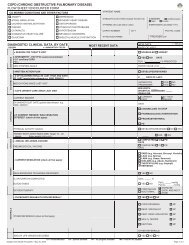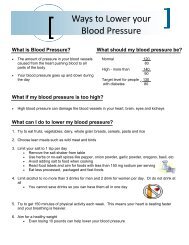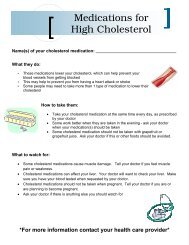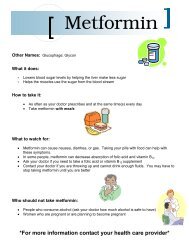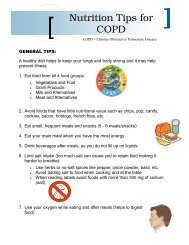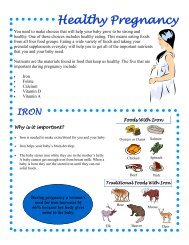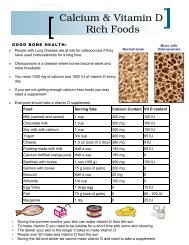Type 2 Diabetes: Your guide to getting started - Saskatchewan Health
Type 2 Diabetes: Your guide to getting started - Saskatchewan Health
Type 2 Diabetes: Your guide to getting started - Saskatchewan Health
You also want an ePaper? Increase the reach of your titles
YUMPU automatically turns print PDFs into web optimized ePapers that Google loves.
<strong>Type</strong> 2 <strong>Diabetes</strong>:<br />
<strong>Your</strong> Guide To Getting Started<br />
Information on:<br />
What is <strong>Type</strong> 2 <strong>Diabetes</strong><br />
<strong>Health</strong>y Eating<br />
Active Living<br />
Blood Glucose Testing
Living Well With <strong>Diabetes</strong><br />
The information in this booklet can help you start <strong>to</strong> take care of<br />
your diabetes. You will find information that will give you the <strong>to</strong>ols<br />
you need <strong>to</strong> take charge of your diabetes care. It will also let you<br />
know who <strong>to</strong> call for assistance as you begin your journey of living<br />
a long, healthy life with diabetes.<br />
When you first hear you have diabetes, you may feel scared,<br />
shocked, overwhelmed or even angry. These feelings are<br />
common. Stay positive. <strong>Diabetes</strong> is manageable. You can do it!<br />
Others living with diabetes are a great support.<br />
Talk <strong>to</strong> someone <strong>to</strong>day.<br />
As you learn <strong>to</strong> live healthy with diabetes talk <strong>to</strong> your<br />
friends and family about your diabetes and let them<br />
offer support.<br />
Remember there are many people and agencies that<br />
can help you. Call <strong>to</strong>day.
General <strong>Health</strong>y Living Guidelines<br />
Eat in a healthy way; follow Canada’s Food Guide<br />
Strive for daily physical activity<br />
Maintain a healthy weight<br />
Keep your blood sugar levels in your target range<br />
Have your blood pressure checked every 3-6 months<br />
Keep your cholesterol and other blood fats in target range<br />
Take your medications as directed<br />
Don’t smoke or chew <strong>to</strong>bacco<br />
Seek help if you feel anxious, depressed or stressed<br />
Discuss with your health professional what you can do<br />
<strong>to</strong> stay healthy.<br />
KNOW YOUR ABCs of diabetes care<br />
A = A1C (measure of blood sugar levels over previous<br />
2-3 months)<br />
Target 7% or lower<br />
B = Blood Pressure Target 130/80 mm/Hg or lower<br />
C = Cholesterol LDL: 2 mmol/L or lower<br />
Total cholesterol <strong>to</strong> HDL ratio 4 or lower
Understanding <strong>Type</strong> 2 <strong>Diabetes</strong><br />
Use this diagram <strong>to</strong> understand what happens when you eat. The<br />
numbers correspond <strong>to</strong> the statements on the following page.<br />
Let’s look at how the body uses sugar:
Let’s look at how the body uses sugar:<br />
1<br />
When you eat food, it gets broken down in your s<strong>to</strong>mach.<br />
Food travels from your s<strong>to</strong>mach <strong>to</strong> the intestine.<br />
2 Much of the food you eat gets broken down in<strong>to</strong> glucose and<br />
goes in<strong>to</strong> your blood. Glucose and sugar mean the same thing.<br />
3<br />
As the amount of sugar starts <strong>to</strong> rise in the blood stream,<br />
the pancreas releases insulin.<br />
4<br />
Insulin carries the sugar from the blood and unlocks the door<br />
of the cells in your body <strong>to</strong> let the sugar in. All cells need sugar<br />
for energy.<br />
5<br />
When there is <strong>to</strong>o much sugar, it gets s<strong>to</strong>red in the liver or<br />
changed in<strong>to</strong> fat. The liver will deliver sugar <strong>to</strong> the blood when you<br />
need it, such as when you are sleeping.<br />
Glucose and sugar mean the same thing.<br />
What Happens When You Have <strong>Type</strong> 2 <strong>Diabetes</strong><br />
• <strong>Your</strong> body cannot use insulin properly<br />
• <strong>Your</strong> body does not make enough insulin<br />
• <strong>Your</strong> liver may put glucose back in<strong>to</strong> the blood when not needed<br />
This causes the sugar <strong>to</strong> stay in the blood and you have<br />
high blood sugar.<br />
<strong>Type</strong> 2 <strong>Diabetes</strong> is <strong>to</strong>o much sugar in the blood.<br />
The Good News Is ....<br />
<strong>Diabetes</strong> can be managed by healthy eating,<br />
active living and medications.
<strong>Health</strong>y Eating<br />
<strong>Health</strong>y eating helps you feel great, manage your ABCs<br />
of diabetes, and maintain a healthy weight.<br />
What a Balanced Meal Looks Like!<br />
milk<br />
Vegetables<br />
(at least 2 kinds)<br />
fruit<br />
Grains &<br />
Starches<br />
(pota<strong>to</strong>, rice,<br />
corn, pasta)<br />
Meat &<br />
Alternatives<br />
(fish, lean meat,<br />
chicken, beans,<br />
lentils)<br />
Be sure <strong>to</strong> eat breakfast. It provides a good start<br />
<strong>to</strong> the day.<br />
It is natural <strong>to</strong> have questions about what food <strong>to</strong> eat.<br />
A dietitian can help you. See contact information<br />
on back page.
<strong>Health</strong>y Eating Guidelines:<br />
The following information can be used in combination with Canada’s<br />
Food Guide:<br />
• Eat 3 balanced meals every day.<br />
• Space your meals no more than 4 – 6 hours apart.<br />
• If snacks are a part of your day, include a healthy snack<br />
between your meals and/or before bed.<br />
• Choose whole grain breads, cereals, noodles, brown rice or<br />
pota<strong>to</strong>es with skin at every meal.<br />
• Eat more vegetables.<br />
• Use low fat cooking methods (grilling, broiling, baking, poaching<br />
or barbequing) instead of frying.<br />
• Limit your salt intake. Processed and fast foods tend <strong>to</strong><br />
have higher levels of salt (e.g. bologna, wieners, TV dinners,<br />
canned or dried soups).<br />
• Limit your intake of alcohol as it may affect your blood sugars.<br />
Drinking fruit juice, regular<br />
pop and sweetened drinks<br />
will raise your blood sugar.<br />
If thirsty, water is the best<br />
choice.
Carbohydrate<br />
• Carbohydrate includes grains and starches, milk, fruit<br />
and sugars<br />
You need carbohydrate as the main source of energy<br />
for your body<br />
• Carbohydrates break down in<strong>to</strong> sugar which goes in<strong>to</strong> your<br />
bloodstream<br />
• Include carbohydrate foods with each meal<br />
When planning a meal your hands can be very useful:<br />
Choose an amount the size of your fist.<br />
Grains and Starches<br />
Fruits<br />
Milk & Alternatives<br />
Have an 8 oz (250 ml) glass of 1% or<br />
skim milk or ¾ cup (175 ml) of yogurt<br />
at each meal<br />
Choose MORE often:<br />
• Whole grain breads,<br />
crackers, and baked<br />
bannock<br />
• Whole grain cereals<br />
and noodles<br />
• Brown and wild rice<br />
and other grains<br />
• Beans, peas and lentils<br />
• Pota<strong>to</strong> and corn<br />
• Milk and yogurt<br />
(less than 2% milk fat)<br />
• Fruit<br />
• Wild berries<br />
Choose LESS often:<br />
• Fruit juice, regular pop,<br />
sweetened drinks, and<br />
drinks made from crystals<br />
• Baked goods, muffi ns,<br />
cakes and pies<br />
• Sugar, honey, syrup, jam,<br />
jelly and molasses<br />
• French fries and<br />
pota<strong>to</strong> chips<br />
• Candy and chocolate<br />
• Ice cream and<br />
frozen yogurt
Protein<br />
Protein includes meat and alternatives (dried beans and lentils)<br />
Protein is not changed in<strong>to</strong> sugar in your body<br />
Protein foods help build muscles and maintain all body tissues<br />
Eating large amounts of protein can cause weight gain and can<br />
damage the heart and blood vessels<br />
Choose an amount of protein up <strong>to</strong> the size of the palm of your hand<br />
and the thickness of your little finger at each meal.<br />
Foods that contain Protein:<br />
• Lean meat – beef/pork<br />
• Beans, peas and lentils *<br />
• Poultry (without skin)<br />
• Eggs<br />
• Fish and shellfish<br />
• Soy products, i.e. <strong>to</strong>fu<br />
• Nuts & seeds (unsalted)<br />
(small portions)<br />
• Cheese (less than 20%<br />
milk fat [MF])<br />
• Peanut butter<br />
• Wild meat and game<br />
* Also contain carbohydrate
Fat<br />
Fat does not change in<strong>to</strong> sugar in your body<br />
Fat is needed for growth and protection of organs<br />
Eating <strong>to</strong>o much fat can cause weight gain and can damage<br />
the heart and blood vessels<br />
Limit fat <strong>to</strong> an amount the size of the tip of your thumb at each meal.<br />
olive<br />
oil<br />
low fat<br />
dressing<br />
Soft Margarine<br />
Soft Margarine<br />
Choose MORE often:<br />
• Non-hydrogenated<br />
margarine<br />
• Vegetable oil<br />
(canola, sunfl ower)<br />
• Nuts and seeds<br />
(small portions)<br />
• Low-fat salad dressings<br />
• Avocado<br />
Choose LESS often:<br />
• Butter and hard/block<br />
margarine<br />
• Shortening and lard<br />
• Bacon<br />
• Skin of chicken<br />
• Cream, cream cheese,<br />
sour cream<br />
• Fried food
Vegetables<br />
Vegetables are full of vitamins and minerals and provide fiber<br />
Most vegetables are low in carbohydrates (except pota<strong>to</strong>es<br />
and corn)<br />
Enjoy them freely!<br />
Choose as many vegetables as you can hold in both hands<br />
at each meal.<br />
• Broccoli<br />
• Cauliflower<br />
• Peas<br />
• Green / yellow beans<br />
• Celery<br />
• Carrots<br />
• Cucumber<br />
• Coloured peppers<br />
• Mushrooms<br />
• Eggplant<br />
• Spinach<br />
• Cabbage<br />
• Brussel sprouts<br />
• Zucchini<br />
• Lettuce and other greens<br />
• Asparagus<br />
• Mixed vegetables<br />
• Squash<br />
• Beets<br />
• Toma<strong>to</strong>es<br />
• Turnips<br />
• Radishes<br />
• Onions
Sample Meal plan #1<br />
Breakfast<br />
High-fibre cereal (½ cup/125 ml)<br />
Toast (1 slice)<br />
1 Orange<br />
Low-fat milk (1 cup/250 ml)<br />
Peanut butter (1 tbsp/15 ml)<br />
Tea or coffee and/or water<br />
Suggestions for larger appetites:<br />
• Add 1 slice of <strong>to</strong>ast (or a<br />
small bagel) with 1 tbsp<br />
(15 ml) peanut butter<br />
Lunch<br />
1 sandwich<br />
- 2 slices whole wheat bread Suggestions for larger appetites:<br />
or 6” pita<br />
• Add 1 cup (250 ml)<br />
- lean meat, chicken, fish (2 oz/60 g) of broth soup<br />
- <strong>to</strong>ma<strong>to</strong> slices and lettuce • Add 1 oz (30 g) of lean meat,<br />
- margarine (1 tsp/5 ml)<br />
chicken or fish <strong>to</strong> the<br />
Carrot or celery sticks<br />
sandwich<br />
Low fat fruit yogurt (½ cup/125ml) or 1 fruit<br />
Tea or coffee and/or water<br />
Dinner (Supper)<br />
Baked pota<strong>to</strong> (1 medium) or rice ( ₂ ³ cup/150 ml)<br />
or noodles/pasta (1 cup/250 ml)<br />
Vegetables<br />
Margarine (1 tsp/5 ml)<br />
Lean meat, chicken or fish (2 oz/60 g)<br />
Green salad<br />
Low-fat dressing (1 tbsp/15 ml)<br />
Grapes (15) or 1 pear<br />
Low-fat milk (1 cup/250 ml)<br />
Tea or coffee and/or water<br />
Suggestions for larger appetites:<br />
• Have a large pota<strong>to</strong> or<br />
1 cup (250 ml) rice or<br />
1 ½ cups (375 ml) noodles<br />
• Add 2 oz (60 g) of lean meat,<br />
chicken or fish<br />
How do your<br />
hands compare <strong>to</strong><br />
these measured<br />
amounts<br />
*Adapted with permission from Just the Basics(c) Canadian <strong>Diabetes</strong> Association 2007
Sample Meal plan #2<br />
Breakfast<br />
1 egg (poached)<br />
Ham (1 oz/30 g)<br />
Whole wheat English muffin<br />
or bannock<br />
Low-fat milk (1 cup/250 ml)<br />
Tea or coffee and/or water<br />
Suggestions for larger appetites:<br />
• Add 1 oz (30 g) ham<br />
• Add a fruit<br />
Lunch<br />
Suggestions for larger appetites:<br />
Wild meat (2 oz/60 g)<br />
• Add 1 oz (30 g) wild meat<br />
Raw carrots<br />
• Add ½ cup (125 ml)<br />
Sliced cucumber<br />
whole wheat spaghetti and<br />
Low-fat ranch dressing for dip<br />
¼ cup (50 ml) <strong>to</strong>ma<strong>to</strong> sauce<br />
(1 tbsp/15 ml)<br />
Whole wheat spaghetti (3/4 cup/175 ml)<br />
Toma<strong>to</strong> sauce (¼ cup/50 ml)<br />
Unsweetened, canned fruit (1/2 cup/125 ml)<br />
Tea or coffee and/or water<br />
Dinner (Supper)<br />
Wild meat stew (2 cups/500 ml)<br />
Whole wheat bun (1)<br />
Margarine (1 tsp/5 ml)<br />
Tossed salad<br />
Low-fat dressing (1 tbsp/15 ml)<br />
Low-fat milk (1/2 cup/125 ml)<br />
Tea or coffee and/or water<br />
Suggestions for larger appetites:<br />
• Add ½ cup (125 ml)<br />
wild meat stew<br />
• Add ½ cup (125 ml)<br />
low-fat milk<br />
Snacks are optional...if snacks are part of your day, try:<br />
• 1 piece of whole wheat <strong>to</strong>ast with 1 tbsp (15 ml) peanut butter<br />
• ¼ cup (50 ml) roasted, unsalted almonds<br />
• 1 medium apple or banana with 1 oz (30 g) of low-fat cheese<br />
• 3/4 (175 ml) cup low-fat yogurt<br />
• whole grain crackers (8) with 1 oz (30 g) low-fat cheese<br />
• ½ cup (125 ml) whole grain cereal with low-fat milk
Active Living<br />
Active living is anything that will get you moving such as walking,<br />
dancing, or working in the yard.<br />
The benefi ts of active living:<br />
• Helps you deal with stress<br />
Improves your ABCs<br />
Uses up extra sugar in<br />
your blood and helps your<br />
own insulin work better<br />
Makes you feel more energetic<br />
Makes your heart and bones strong<br />
Helps blood fl ow and <strong>to</strong>nes muscles<br />
Keeps your body and your joints fl exible<br />
Helps control weight<br />
You can be active without going<br />
<strong>to</strong> the gym, playing sports or<br />
using fancy equipment.<br />
Active living begins with a single step. It’s never <strong>to</strong>o late <strong>to</strong> improve<br />
your level of fi tness!<br />
Being active is good<br />
for your body and state<br />
of mind.<br />
If you have not exercised much<br />
in the past, talk <strong>to</strong> your doc<strong>to</strong>r or<br />
nurse practitioner <strong>to</strong> make sure<br />
it is safe for you <strong>to</strong> start.
Suggestions for Active Living<br />
Start slowly, listen <strong>to</strong> your body<br />
Choose activities you enjoy<br />
Set realistic goals<br />
Walk whenever you can:<br />
- park the car farther away<br />
- walk <strong>to</strong> do your errands<br />
- take the stairs<br />
- walk the halls of your building<br />
- take a nature walk<br />
Reduce long periods of sitting, watch TV less or use the<br />
computer less<br />
Stretch for a few minutes every hour<br />
Check out the fitness programs and services in your community<br />
and see if anything interests you<br />
Try one class <strong>to</strong> start – you don’t have <strong>to</strong> make a long-term<br />
commitment<br />
Start with the activities you are doing now, but do them<br />
more often<br />
Join a friend who is already active<br />
Minutes count!<br />
• Add it up – 10 minutes at a time.<br />
• Aim for 30-60 minutes of activity<br />
every day.
<strong>Type</strong>s of Activities<br />
Endurance, fl exibility and strengthening activities keep your<br />
body healthy.<br />
Endurance:<br />
Helps your heart and lungs by increasing your heart rate<br />
and breathing.<br />
Walking<br />
Yard work<br />
Dancing<br />
Skating<br />
Swimming<br />
Flexibility:<br />
Helps you move easily, keeping your muscles relaxed and your<br />
joints mobile.<br />
• Gardening<br />
Mopping/vacuuming<br />
Curling/golfing<br />
Bowling<br />
Yoga, Pilates, Tai Chi<br />
Strength:<br />
Helps your muscles and bones stay strong and improves<br />
your posture.<br />
Cutting wood<br />
Shovelling snow<br />
Raking and carrying leaves<br />
Climbing stairs<br />
Strength training routines<br />
Lifting weights<br />
Try <strong>to</strong> do some of each<br />
type every day.
Taking Medication<br />
Good diabetes management is about you taking control of your<br />
blood glucose, blood pressure and cholesterol. In addition <strong>to</strong><br />
choosing healthy foods and increasing your activity level,<br />
medications may be needed <strong>to</strong> get your numbers in target range.<br />
Often, more than one medication is required <strong>to</strong> manage the ABCs<br />
of your diabetes care.<br />
ABCs of diabetes<br />
A = A1C (Blood Sugar)<br />
B = Blood Pressure<br />
C = Cholesterol<br />
Blood glucose may be treated with pills and/or<br />
insulin injections<br />
Over time your medications will change<br />
Medications may be needed <strong>to</strong> manage blood pressure and<br />
cholesterol. Ask your doc<strong>to</strong>r what is right for you.<br />
Low dose aspirin (ASA) can reduce the risk of heart attacks<br />
for most people with diabetes. Talk <strong>to</strong> your doc<strong>to</strong>r.<br />
Medications have <strong>to</strong> be taken in the right amount and at the<br />
right time<br />
Talk with your pharmacist or doc<strong>to</strong>r <strong>to</strong> make sure you understand<br />
your medications<br />
If you feel you are doing all that you can do and your ABCs<br />
remain high – talk <strong>to</strong> your doc<strong>to</strong>r about your medications<br />
There are many financial costs for<br />
the person living with diabetes.<br />
Talk <strong>to</strong> your pharmacist about<br />
assistance that may be available.<br />
Do not feel that you have<br />
failed when you need <strong>to</strong><br />
change your medications.
Blood Glucose Moni<strong>to</strong>ring<br />
Why Should I Test My Blood Glucose Levels<br />
Blood glucose moni<strong>to</strong>ring puts you in control of your diabetes<br />
It helps you understand how food, activity, and medications<br />
affect your blood glucose<br />
You need <strong>to</strong> test your blood glucose so you know what it is<br />
How Do I Test My Blood Glucose Levels<br />
A blood glucose meter is used <strong>to</strong> test your blood glucose. Meters<br />
can be purchased at most pharmacies. A pharmacist or diabetes<br />
educa<strong>to</strong>r can provide you with the training you need <strong>to</strong> use<br />
your meter.<br />
Ask your diabetes educa<strong>to</strong>r or pharmacist about:<br />
The size of the drop of blood needed<br />
Where and how <strong>to</strong> poke your fi nger<br />
Does the meter need <strong>to</strong> be coded<br />
How <strong>to</strong> check if the meter is accurate<br />
What <strong>to</strong> do with used lancets<br />
Always wash your<br />
hands before testing.<br />
Remember, moni<strong>to</strong>ring<br />
assists you in managing<br />
your diabetes.
When and How Often Do I Test<br />
It is recommended that you check your blood sugar regularly<br />
and record results in your logbook. To start, check your blood<br />
sugar one day per week.<br />
Suggested times <strong>to</strong> test are:<br />
• Before meals<br />
2 hours after a meal<br />
At bedtime<br />
Remember <strong>to</strong> check your blood<br />
sugars at different times of the day.<br />
In your log book:<br />
Record in the correct column for the time of day<br />
Add comments about your day – activities, stress, food<br />
Increase your blood glucose testing if:<br />
• <strong>Your</strong> blood sugar is <strong>to</strong>o high or <strong>to</strong>o low<br />
You become ill or are stressed<br />
There are changes <strong>to</strong> your food choices, activity level<br />
or medication<br />
What are my Blood Glucose Targets<br />
• Between 4 – 7 mmol/L before eating<br />
• Between 5 – 10 mmol/L two hours<br />
after eating<br />
Individual targets may be<br />
recommended by your health<br />
professional.
High Blood Sugar<br />
What is high blood sugar<br />
Blood sugar that is higher than the target range.<br />
When it might happen<br />
You are ill<br />
You are under stress<br />
<strong>Your</strong> medications, eating and activity are not in balance<br />
How you may feel<br />
Tired<br />
Thirsty<br />
Urinate frequently<br />
Blurred vision<br />
What <strong>to</strong> do when your blood sugars are often higher than 11 mmol/L:<br />
Talk <strong>to</strong> your doc<strong>to</strong>r, nurse practitioner or pharmacist as<br />
medications may need <strong>to</strong> be changed<br />
See a diabetes educa<strong>to</strong>r<br />
Be more active – see activity section<br />
What <strong>to</strong> do when you are sick:<br />
If you use insulin or some diabetes medications, you need <strong>to</strong> keep a<br />
close check on your blood sugars when you are ill. You may need <strong>to</strong>:<br />
Test your blood sugars every 2-4 hours.<br />
Continue <strong>to</strong> take your diabetes medication and/or insulin.<br />
Drink plenty of sugar-free fluids.<br />
Consume some carbohydrate every hour - try juice or regular pop<br />
if you cannot eat.<br />
Call your doc<strong>to</strong>r or go <strong>to</strong> a medical centre if you vomit more<br />
than twice in 12 hours or if you feel you need <strong>to</strong> discuss<br />
your illness.
Low Blood Sugar<br />
What is a low blood sugar<br />
Blood sugar less than 4 mmol/L.<br />
When it might happen<br />
You are on insulin or certain diabetes medication<br />
You didn’t eat enough<br />
You are more active<br />
<strong>Your</strong> medication needs adjusting<br />
How you may feel<br />
You may feel shaky, light-headed, nervous, irritable, confused,<br />
hungry, sweaty, headachy, weak, numb around lips/mouth.<br />
If you experience low blood sugar, you need<br />
<strong>to</strong> treat it right away!!<br />
What do you do<br />
1 Eat or drink one fast acting sugar choice:<br />
2<br />
3<br />
15 g of glucose in the form of glucose tablets<br />
3 tsp (15 g) sugar, honey or syrup<br />
¾ cup (175 ml) of juice or regular pop<br />
Wait 10 <strong>to</strong> 15 minutes; check your blood sugar again.<br />
If it is still low:<br />
Treat again!<br />
Continue <strong>to</strong> treat until blood sugar is greater than 4 mmol/L<br />
If your next meal is more than 1 hour away, or you are going<br />
<strong>to</strong> be active, eat a snack, such as one of the following:<br />
½ meat sandwich<br />
6 soda crackers and cheese<br />
1 slice of <strong>to</strong>ast with peanut butter or 1 oz of low fat cheese
Important Tests for Good Basic Care:<br />
The following are important tests for diabetes care. You may need<br />
some tests more often than indicated below. Know what tests are<br />
recommended and talk <strong>to</strong> your doc<strong>to</strong>r or nurse practitioner about<br />
these tests.<br />
When<br />
At diagnosis<br />
Approximately every<br />
3 months<br />
Every 6 <strong>to</strong> 12 months<br />
Every year<br />
Every 1 <strong>to</strong> 2 years<br />
Regularly/Periodically<br />
What Test<br />
• Kidney tests: test performed at the lab<br />
• Eye examination through dilated pupils<br />
by an eye specialist<br />
• Foot examination <strong>to</strong> check for nerve<br />
damage and other problems<br />
• Questions about your ability <strong>to</strong> get<br />
and maintain an erection and if you<br />
experience foot and leg pain when<br />
walking<br />
• Cholesterol and other blood fat tests<br />
• A1C<br />
• Blood pressure<br />
• Foot examination at least once a year<br />
and sooner for skin wounds or sores<br />
that don’t heal quickly<br />
• Kidney tests<br />
• Meter check against a lab fasting<br />
blood glucose test<br />
• Eye examination by an eye specialist<br />
or op<strong>to</strong>metrist – more often if eye<br />
disease is present<br />
• Cholesterol and other blood fats tests<br />
• Questions about depression<br />
and/or anxiety<br />
• Self check of feet<br />
• Blood pressure
Developed by the <strong>Type</strong> 2 <strong>Diabetes</strong> Provincial Working<br />
Group. Information in this resource was provided in part by<br />
the Canadian <strong>Diabetes</strong> Association.
Contact Information and Resources<br />
To find a <strong>Diabetes</strong> Educa<strong>to</strong>r:<br />
• Call your local <strong>Health</strong> Region.<br />
• Call the <strong>Health</strong>Line @ 1-877-800-0002.<br />
• On Reserve call your local Community <strong>Health</strong> Clinic or Tribal Council.<br />
• Ask your doc<strong>to</strong>r or nurse practitioner.<br />
• To fi nd a Live Well with Chronic Conditions Program call<br />
the <strong>Health</strong>Line @ 1-877-800-0002.<br />
For <strong>Diabetes</strong> Information Contact:<br />
Canadian <strong>Diabetes</strong> Association (CDA)<br />
1-800-BANTING (226-8464) www.diabetes.ca<br />
CDA North <strong>Saskatchewan</strong> Regional Leadership Centre<br />
1-800-996-4446<br />
CDA South <strong>Saskatchewan</strong> Regional Leadership Centre<br />
1-800-297-7488<br />
<strong>Saskatchewan</strong> <strong>Health</strong>Line<br />
1-877-800-0002 www.healthlineonline.ca<br />
First Nations Inuit <strong>Health</strong><br />
(306) 780-5449 www.hc-sc.gc.ca/fnih-spni/index_e.html<br />
National Aboriginal <strong>Diabetes</strong> Association<br />
1-877-232-6232 www.nada.ca<br />
Websites:<br />
Dietitians of Canada<br />
Heart and Stroke Foundation<br />
<strong>Health</strong> Canada-Canada’s Food Guide<br />
In Motion<br />
International <strong>Diabetes</strong> Federation<br />
Kidney Foundation of Canada, Sask Branch<br />
<strong>Saskatchewan</strong> Ministry of <strong>Health</strong><br />
<strong>Saskatchewan</strong> Prevention Institute<br />
www.dietitians.ca<br />
www.heartandstroke.ca<br />
www.healthcanada.gc.ca/food<strong>guide</strong><br />
www.in-motion.ca<br />
www.idf.org<br />
www.kidney.sk.ca<br />
www.health.gov.sk.ca<br />
www.preventioninstitute.sk.ca<br />
Remember, the more you learn about diabetes<br />
the better able you are <strong>to</strong> take charge of your diabetes.<br />
September 2008


